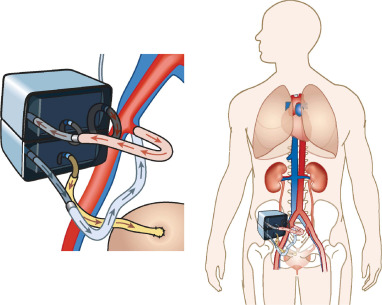There are 2 million people in the world who require kidney dialysis every week to clean their blood. This is a time-consuming and cumbersome process, without which the patient dies.
A team at the University of California, San Francisco, has developed the first implantable artificial kidney, a coffee-cup-sized box containing silicon filters and live kidney cells grown in a bioreactor that can be connected to the patient’s circulatory system and bladder to clean the blood 24 hours a day. (Solon, 2018)
These two advanced technologies will make up a small biocompatible device that attaches to the circulatory system and removes toxins to the bladder as waste.
The artificial kidney will allow patients to live untethered from dialysis machines eat and drink more normally and live their lives more freely. In addition to giving patients freedom to roam during dialysis, it would also address the shortfall of donated organs. Only one in six people waiting for a kidney received one in 2016.
Creating an artificial implantable kidney would be an epic advance in medicine and could address a chronic shortage of donor kidneys needed for transplant. Researchers have been at this quest for the past 15 years and keep coming upon one extremely knotty problem: how to keep the blood flowing smoothly through the artificial device without clotting. In such devices, as blood platelets respond to mechanical forces, they have a natural tendency to clot, causing a device malfunction. (Pharm.ucsf.edu, 2018)
The researchers generated simulation and optimization results for two device designs that each channel blood through the artificial kidney filter system. One design distributes blood through parallel channels that pass across multiple layers of filtering membranes. The other channels blood back and forth through a single serpentine path.
Both designs met the researchers’ predetermined criteria for the uniform flow of blood through the devices and accumulation of shear stress forces on the platelets against the walls of the device flow channels. The Kidney Project have already received an abundance of applications for the human trials. Screenings will proceed once they receive approval from the board of ethics.
“If all goes well and funds are available, we could be on the market as early as 2020.”, Shuvo Roy, one of the study’s co-authors told back in March 2018. Completion of this ambitious project will profoundly improve the quality and length of life for patients with kidney failure as well as reduce the cost in personal toll of this devastating disease.
References:
Pharm.ucsf.edu. (2018). Home | The Kidney Project | UCSF. [online] Available at: https://pharm.ucsf.edu/kidney [Accessed 22 Oct. 2018].
Solon, O. (2018). Forget Juicero, here are the tech gadgets we can actually get excited about in 2018. [online] the Guardian. Available at: https://www.theguardian.com/technology/2017/dec/28/tech-inventions-to-look-foward-2018 [Accessed 22 Oct. 2018].


